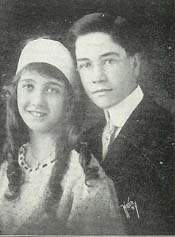

Photographs of this foster brother
and sister and their foster mother (above), and their “fine
foster home” in Florida (pictured below) early in the twentieth
century reinforced the close association between adoption and
upward mobility. During the century, adoption invariably moved
children from poorer families, communities, and nations to richer
ones.


This brochure for the National Home
Finding Society, probably from the late 1910s or 1920s, linked
child-placing with utopian progress. Adoption promised to “reduce
divorces, banditry, murder, and control births, fill all the churches
and do real missionary work at home and abroad, exchanging immigrants
for Americans and stopping some of the road leading to war.”
|
|
Since ancient times and in all
human cultures, children have been transferred from adults who would
not or could not be parents to adults who wanted them for love,
labor, and property. Adoption’s close association with humanitarianism,
upward mobility, and infertility,
however, are uniquely modern phenomena. An especially prominent
feature of modern adoption history has been matching:
the idea that adoption substituted one family for another so carefully,
systematically, and completely that natal kinship was rendered invisible
and irrelevant. This notion was unusual in the history of family
formation, especially because the most obvious thing about adoption
has been that it is a different way to make a family. Practices
that aimed to hide this difference ironically made modern adoption
most distinctive.
In the United States, state legislatures began passing adoption
laws in the nineteenth-century. The Massachusetts
Adoption of Children Act, enacted in 1851, is widely considered
the first “modern” adoption law. Adoption reform in
other western industrial nations lagged. England, for example, did
not pass adoption legislation until 1926. Observers have frequently
attributed the acceptance of adoption in the United States to its
compatibility with cherished national traditions, from immigration
to democracy. According to this way of thinking, solidarities achieved
on purpose are more powerful—and more quintessentially American—than
solidarities ascribed to blood. Yet adoption has always had a symbolic
importance that outstripped its statistical significance. Adoption
has touched only a small minority of children and adults while telling
stories about identity and belonging that include us all.
During the twentieth century, numbers of adoptions increased dramatically
in the United States. In 1900, formalizing adoptive kinship in a
court was still very rare. By 1970, the numerical peak of twentieth-century
adoption, 175,000 adoptions were finalized annually. “Stranger”
or “non-relative” adoptions have predominated over time,
and most people equate adoption with families in which parents and
children lack genetic ties. Today, however, a majority of children
are adopted by natal relatives and step-parents, a development that
corresponds to the rise of divorce, remarriage, and long-term cohabitation.
Conservative estimates (which do not include informal adoptions)
suggest that five million Americans alive today are adoptees, 2-4
percent of all families have adopted, and 2.5 percent of all children
under 18 are adopted. Accurate historical
statistics about twentieth-century adoption are, unfortunately,
almost impossible to locate. A national reporting system existed
for only thirty years (from 1945 to 1975) and even during this period,
data was supplied by states and territories on a purely voluntary
basis.
We do know that adoptive kinship is not typical. Families touched
by adoption are significantly more racially diverse, better educated,
and more affluent than families in general. We know this because
in 2000, “adopted son/daughter” was included as a census
category for the first time in U.S. history.
Since World War II, adoption has clearly globalized. From Germany
in the 1940s and Korea in the 1950s to China and Guatemala today,
countries that export children for adoption have been devastated
by poverty, war, and genocide. Because growing numbers of adoptions
are transracial and/or international,
many of today’s adoptive families have literally made adoption
more visible than it was in the past. But total numbers of adoptions
have actually declined since 1970. In recent years, approximately
125,000 children have been adopted annually by strangers and relatives
in the United States.
Modern adoption history has been marked by vigorous reforms dedicated
to surrounding child placement with legal and scientific safeguards
enforced by trained professionals working under the auspices of
certified agencies. In 1917, for instance, Minnesota
passed the first state law that required children and adults to
be investigated and adoption records to be shielded from public
view. By midcentury, virtually all states in the country had revised
their laws to incorporate such minimum
standards as pre-placement inquiry, post-placement probation,
and confidentiality and sealed records.
At their best, these standards promoted child
welfare. Yet they also reflected eugenic
anxieties about the quality of adoptable children and served to
make adult tastes and preferences more influential in adoption than
children’s needs.
Since 1950, a number of major shifts have occurred. First, “adoptability”
expanded beyond “normal” children to include older,
disabled, non-white, and other children with special
needs. Since 1970, earlier reforms guaranteeing confidentiality
and sealed records have been forcefully criticized and movements
to encourage search, reunion, and
“open adoption” have mobilized sympathy and support.
The adoption closet has been replaced by an astonishing variety
of adoption communities and communications. Adoption is visible
in popular culture, grassroots organizations, politics, daily media,
and on the internet.
Adoption history illustrates that public and private issues are
inseparable. Ideas about blood and belonging, nature and nurture,
needs and rights are not the exclusive products of individual choices
and personal freedoms. They have been decisively shaped by law and
public policy and cultural change, which in turn have altered Americans’
ordinary lives and the families in which they live and love.
|



